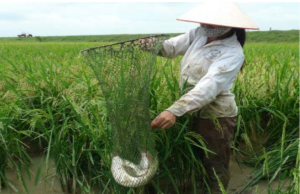Stories from the field

Save & Grow practices utilizing integrated rice-fish-aquatic biodiversity increases gross income by 210%-550%
The Regional Rice Initiative (RRI), a pilot of the Strategic Objective 2 “Sustainable Management of Agriculture, Forestry and Fisheries” of the Food and Agriculture Organization of the United Nations, is designed to focus on the importance of goods and services produced by and available from rice ecosystems, and to identify and locally test sustainable rice production practices to enhance resilience and increase efficiencies in rice production to improve food security. In 2013, pilot activities under the first phase of the project were carried out in Indonesia and the Philippines. At the start of the second phase of the Regional Rice Initiative, Vietnam participated in the workshop on “Experiences and Results Sharing on pilot Save and Grow Farmers Field Schools (FFS) for Sustainable Rice Intensification” held in Bali, Indonesia from 3-5 April 2014.
Vietnam is one of the countries supported by the Swedish-funded FAO Asia Regional Integrated Pest Management (IPM)/Pesticide Risk Reduction Programme.
The Programme maintains a wellestablished network of government and civil society organizations committed to empowerment of rural communities and improving smallholders farmers’ knowledge and skills on ecologically sound agricultural production and protection. The RRI pilot project activities in Indonesia and the Philippines built on the capacities of this network of government and civil society organizations (CSO) partners of the FAO Asia Regional IPM/Pesticide Risk Reduction Programme. In response to the interest of other countries and as a way to expand the utilization of experiences gained from RRI-1, pilot Save and Grow activities to be supported under the Swedish-funded programme were implemented in Vietnam in 2014.
With support from the regional CSO The Field Alliance/Thai Education Foundation and the local CSO, Center of Initiatives on Community Empowerment and Rural Development (ICERD) training on aquatic (including rice-fish) and agrobiodiversity and pesticide impact assessment were carried out for communities. Initial surveys carried out by ICERD showed that farmers in selected sites in Bac Giang and Quang Binh provinces in northern Vietnam practice rearing fish in ponds close to rice fields. Some farmers reportedly released fish from the ponds into the rice fields after harvesting. Pesticide use – about 5-7 applications per crop, not including herbicides – was the key reason. As part of the process of community education on pesticide risk reduction, the FAO-supported National IPM Programme assisted the formulation of Community Action Plans and trained farmers in FFS to reduce pesticide risk, including the use of biological control options for pest management. Among other agreements, various stakeholders in the commune – including local government, people’s organizations (Farmers’ Union, Women’s Union, Youth Union, etc.) and farmers agreed to improve the rice ecosystem as to integrate rice-fish-aquatic biodiversity in the production system.
A total of 105 farmers (55 women) from Bac Giang and Quang Binh applied rice intensification practices learned from FFS to an area of 34 hectares. Rice fields adjacent to each other were selected for the Save and Grow study plots.
Following good principles and practices of Save and Grow, rice farmers applied efficient management, growing healthy, well-yielding crops with fewer and more sustainable production inputs. Farmers explored making optimal use of multiple goods and services of paddy-based farming systems – including conservation and management of aquatic biodiversity (including both captured and cultured fish species) – in combination with improved agronomic practices such as wider plant spacing/reduced seeding rates, improved water management, and reduced chemical pesticides through the application of ecologically sound IPM. This included the use of biological control agents such as Metarhizium anisopliae as an alternative to chemicals for the management of the brown planthopper and natural biological control provided by ecosystem services.
Table 1 summarizes the differences between yields and benefits farmers obtained if the farmers only grew rice and when aquatic biodiversity was integrated in the production system.

The average gross income from integrated rice-fish-aquatic production is US$7,751 compared to US$1,892 obtained from producing only rice. Utilization of integrated rice-fish-aquatic biodiversity production practices resulted in average gross income ranging from 211%-551% compared with producing rice only. Farmers’ experience and the aquatic biodiversity species and numbers – especially fish – accounted for the big difference in benefits. Informed management decision making based on agro-ecosystem analysis, the use of ecosystem services such as natural pest control to avoid unnecessary use of chemical pesticides and the use of biological control agents also contributed to effective and sustainable pest management. The fish provided additional services by eating insect pests found at the stem and base of rice plants and those that fall into the water. The value of these ecosystem services are not reflected in this case study.

The Save and Grow FFS provided opportunities for farmers and other community stakeholders to field test rice intensification practices, making optimal use of the multiple good and services of paddy-based farming systems. The Swedish-supported programme will continue efforts to strengthen community ownership in planning, management and implementation of local IPM/pesticide risk reduction programmes in support of Save and Grow FFS. The challenge now is to scale up the pilot activities to improve quality and efficiency in the rice value chain; address policy issues (e.g. implementation of national /regional rice strategies) and increase resilience and sustainability of rural communities and rice ecosystems and landscapes to address sustainable rice production intensification.



